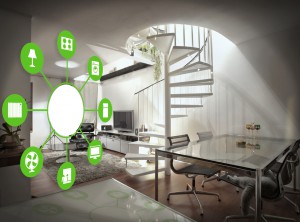By Cutright Elizabeth on March 28, 2016 in Technology
Imagine crossing the threshold after a l ong day at work to a perfectly lit, temperature-controlled living space. As you walk down the hallway, lights flicker for your approach while a disembodied voice welcomes you with a rundown of messages and alerts as your crockpot bubbles aromatically in the kitchen.
ong day at work to a perfectly lit, temperature-controlled living space. As you walk down the hallway, lights flicker for your approach while a disembodied voice welcomes you with a rundown of messages and alerts as your crockpot bubbles aromatically in the kitchen.
It sounds like the stuff of science fiction, but if Samsung, Google and Apple have their way, eventually every home will be a “smart home.”
Highlighting their technology’s ability to keep residents apprised of every activity in their home, Samsung’s Smart Things touts a setup that includes an App (available for iOS and Android), a Hub, and collection of up to 200 customizable devices including thermostats, light bulbs, outlets and sensors. The Smart Things app can push notifications to users, and its devices can turn off and on at particular times or based on temperature and vacation settings. Home monitoring through the app provides instant alerts for intrusions, smoke, leaks and other unusual activity. Adding a camera even allows for video footage of flagged events. The Hub connects via Ethernet, and uses ZigBee and Z-Wave radios for IP compatibility and works with products ranging from Sonos to CREE to Honeywell.
In line with the company’s seeming commitment to simplified, intuitive technology, Google’s Nest products work together to create a “connected” home environment for easy management of a broad range of devices from electric vehicle charger to automated pet feeder. Nest touts itself as a solution for those seeking “the thoughtful home: A home that takes care of the people inside it and the world around it.” Centered on three main products – Nest Cam, Nest Protect, and Nest Learning Thermostat – the Nest app allows users to access live streaming video and control indoor temperatures along with providing safety alerts via enabled mobile devices. Nest also plays well with third party devices, including household appliances, smart cars and a host of smart apps and services.
While Apple’s HomeKit also creates an interconnected network of apps and devices designed for a smart home environment, the company stands apart by also offering data encryption as part of its commitment to user privacy. Siri commands enable voice activation, allow users to lock the front door, control indoor temperatures and much more, just by speaking into their iOS device. HomeKit provides endless configuration, with the ability to set up conditions to trigger any combination of actions including lighting and temperature settings based on location, time of day, or even the weather. Apple also touts the ability to set “scenes” to program a host of actions based on individual circumstances like leaving the house, just waking up or when you’re on your way to bed. HomeKit can also work with third-party products and services, including Nest, along with the standard roster of Apple-exclusive products.
Soon the much-anticipated “Internet of Things” will be a reality. As the above products and their countless imitators prove, it’s only a matter of time before everything will be connect to, and through, the Internet. In less than ten years, it’s predicted that billions of devices will send and receive commands over Wi-Fi, Ethernet and Bluetooth. And while the writers over at WIRED admit the field might be too diverse and siloed for easy and quick implementation, they concede smart homes are inevitable.
“Know this, though: it may be coming like a molasses tidal wave, but the Internet of Things is coming,” writes David Pierce in the magazine’s Gear section. “It’s not a matter of if or whether, but when and how…The tracks have been laid. Maybe it’ll be 2016, maybe the year after, but the train is coming. It’ll have Wi-Fi and Bluetooth and probably eight other things, and you’ll definitely get a push notification when it gets here.”


